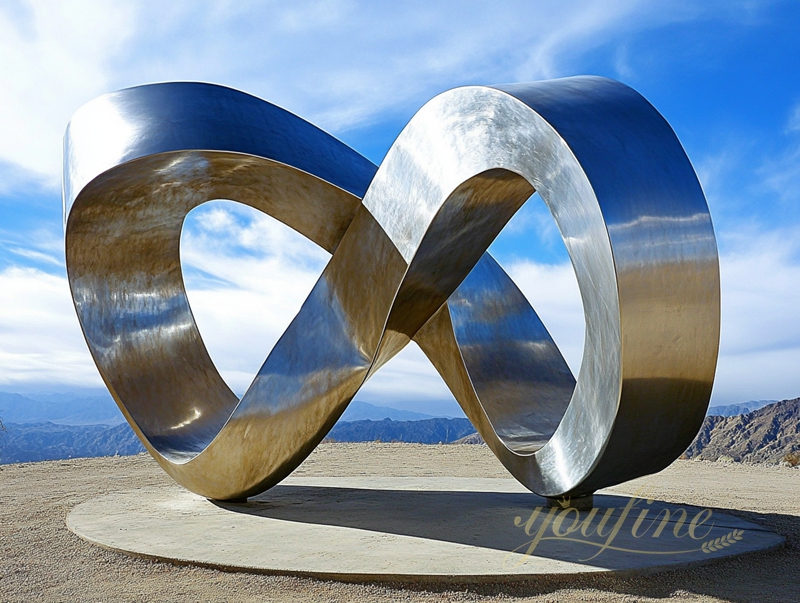Desert environments are known for their stark beauty, vast open spaces, and extreme conditions. Over the past few years, these unique landscapes have become popular venues for displaying art, particularly sculptures made from materials that can withstand such harsh conditions. Among these materials, stainless steel has emerged as a favorite, offering both durability and a striking visual impact.
The Visual Impact of Stainless Steel in Deserts
One of the most compelling reasons artists and curators choose to place stainless steel sculptures in desert environments is the dramatic visual contrast they create. Deserts are typically associated with warm tones—golden sands, red rocks, and clear blue skies. Against this backdrop, the cool, reflective surfaces of stainless steel stand out brilliantly. The material’s ability to mirror its surroundings adds a dynamic element to the artwork, as the sculpture can change appearance throughout the day with the shifting light and colors of the desert.
The reflective quality of stainless steel also interacts with the vast, open spaces of the desert. The way the sculptures catch and reflect light creates a mesmerizing effect, drawing viewers into a visual dialogue between the natural and the man-made. In a landscape that is otherwise sparse, these sculptures become focal points, commanding attention and inviting contemplation.

Durability and Resilience in Extreme Conditions
The desert is an environment of extremes—intense heat during the day, cold temperatures at night, and frequent exposure to strong winds and abrasive sand. Not all materials can withstand these conditions without deteriorating. Stainless steel, however, is well-suited for such challenges. Its inherent resistance to corrosion and rust ensures that sculptures maintain their structural integrity and aesthetic appeal over time.
This durability is not just practical; it’s symbolic. In placing stainless steel sculptures in such unforgiving environments, artists often explore themes of resilience, permanence, and the passage of time. The sculptures, with their enduring material, become a metaphor for human tenacity and the capacity to withstand life’s challenges.
A Harmonious Blend of Art and Nature
Another reason stainless steel sculptures are popular in deserts is the way they harmonize with the natural environment. Despite their modern, industrial appearance, these sculptures often feel like they belong in the desert, particularly when designed to reflect or complement natural forms. For instance, a sculpture might mimic the flowing lines of sand dunes or the jagged edges of a mountain range, creating a seamless blend of art and nature.
This harmonious integration is particularly evident when stainless steel sculptures are paired with natural elements like water or stone. In desert settings, where resources are scarce, such combinations can be especially striking, highlighting the contrast between abundance and scarcity, nature and civilization.
Recommended Stainless Steel Sculptures for Desert Settings
Given the unique characteristics of desert environments, certain types of stainless steel sculptures are particularly well-suited for these settings. Here are a few recommendations:
Abstract Sculptures
– These sculptures, often featuring clean lines and sharp angles, create a striking contrast against the organic forms of the desert landscape. Their reflective surfaces can mirror the changing light and colors of the desert, making them dynamic focal points.
Sculptures Inspired by Natural Forms
– Designs that mimic natural elements like waves, dunes, or spirals can seamlessly integrate with the desert surroundings. For example, a stainless steel sculpture that echoes the shape of a sand dune can appear as a natural extension of the landscape, blurring the line between art and nature.
Monumental Sculptures
– Large-scale sculptures can become landmarks in the desert, drawing visitors from afar. Monumental pieces that rise dramatically from the flat, open landscape can symbolize resilience and human achievement, standing as beacons in the vastness of the desert.
Reflective Surface Sculptures
– Sculptures with highly polished surfaces that reflect the sky, sand, and surrounding landscape create an illusion of blending into their environment. This effect can be especially powerful in a desert, where the sky is vast and ever-changing.
Finally, stainless steel sculptures in deserts often serve as landmarks, drawing visitors to remote areas and boosting local tourism. These installations create a sense of place, turning otherwise desolate landscapes into destinations for art lovers and adventurers alike. The journey to see these sculptures becomes part of the experience, adding to their allure.
For example, large-scale art installations in deserts, such as those at events like Burning Man, have gained international recognition. The stainless steel sculptures featured in these settings not only captivate with their beauty but also contribute to the cultural and economic vitality of the region.
Stainless steel sculptures in desert environments offer a unique blend of visual appeal, durability, and cultural significance. Their reflective surfaces and resilience to harsh conditions make them ideal for such extreme landscapes, where they stand as symbols of both human creativity and endurance. As more artists explore the possibilities of placing stainless steel sculptures in deserts, these installations will continue to captivate and inspire, bridging the gap between art, nature, and the human spirit. The recommended designs—whether abstract, natural, kinetic, monumental, or reflective—are especially well-suited to thrive in the unique and challenging environment of the desert.